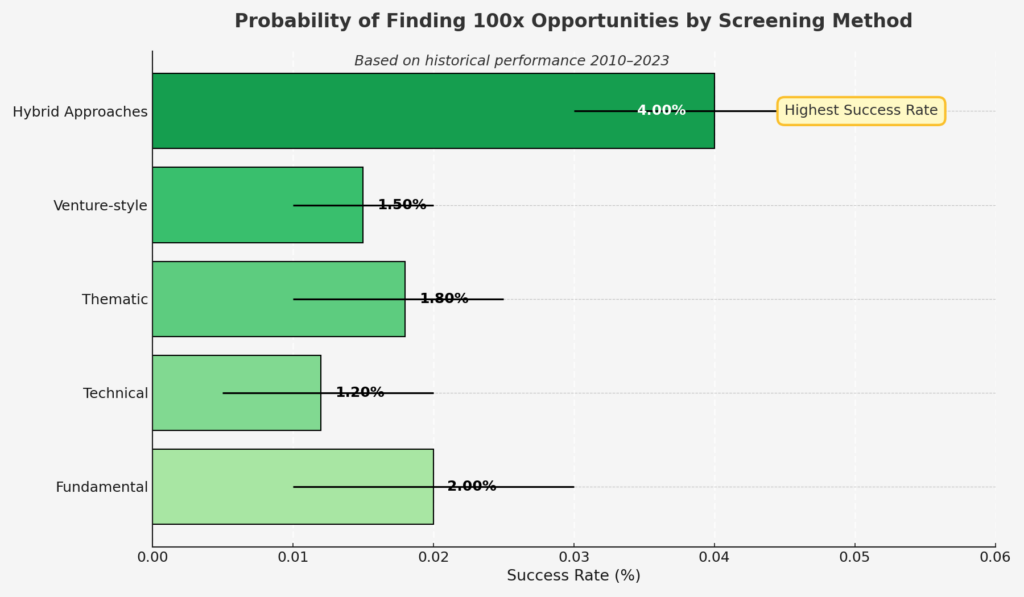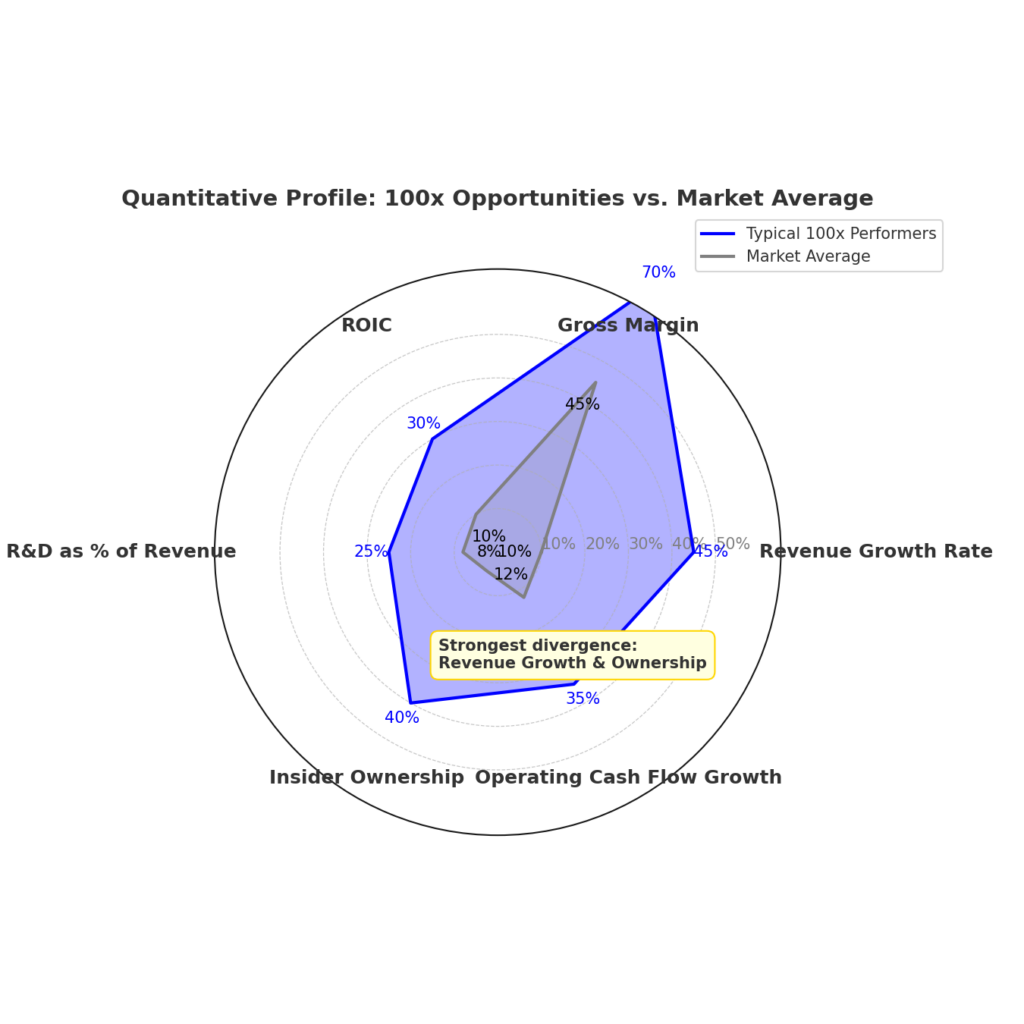In today’s fast-paced financial markets, identifying potential multi-bagger investments before they become mainstream can create life-changing wealth. Investment opportunity screening – the systematic process of filtering investment options based on specific criteria – enables investors to discover overlooked assets with explosive growth potential while minimizing exposure to potential pitfalls.
Key Takeaways
- Effective screening combines quantitative metrics with qualitative analysis: While financial ratios like P/E, P/S, and ROE provide numerical foundations, truly exceptional returns often come from identifying companies with sustainable competitive advantages and visionary leadership, as demonstrated by early investments in Amazon despite its initially challenging financial metrics.
- Multi-stage screening processes outperform single-filter approaches: Investors who discovered 100x opportunities like NVIDIA ($3 in 2015 to over $300 in 2024) typically applied sequential filters—first identifying industries with exponential growth potential, then companies with technological edges, and finally those with proven execution capabilities and healthy balance sheets.
- Patience and continuous re-evaluation are essential complements to any screening methodology: Most 100x investments require 7-10 years to fully materialize; Peter Lynch’s Fidelity Magellan Fund achieved 29% annual returns over 13 years by continuously re-screening his portfolio holdings against emerging competitors and changing market conditions.
Understanding Investment Opportunity Screening
Investment opportunity screening is a systematic approach to filtering potential investments based on predetermined criteria to identify those with the highest probability of exceptional returns. Unlike random selection or headline-driven investing, proper screening methodologies apply consistent, objective standards to evaluate assets across multiple dimensions.
The screening process creates a funnel that starts with a broad universe of thousands of potential investments and progressively narrows them down to a manageable set of high-potential candidates. In the context of seeking 100x returns (investments that multiply original capital by 100 times), screening becomes particularly crucial as these opportunities represent statistical outliers in the market—rare but incredibly impactful when identified.
At its core, effective screening balances quantitative factors (measurable metrics like revenue growth, profit margins, and valuation) with qualitative considerations (management quality, competitive advantages, and industry tailwinds). This dual approach helps investors identify not just financially sound investments but those with the extraordinary potential required to achieve 100x returns.
Modern screening has evolved from simple financial ratio filtering to sophisticated multi-variable analyses incorporating alternative data sources, sentiment analysis, and even artificial intelligence to identify patterns that human analysts might overlook. The democratization of financial data has made basic screening accessible to retail investors, while advanced practitioners develop proprietary methodologies that integrate technical, fundamental, and behavioral factors.
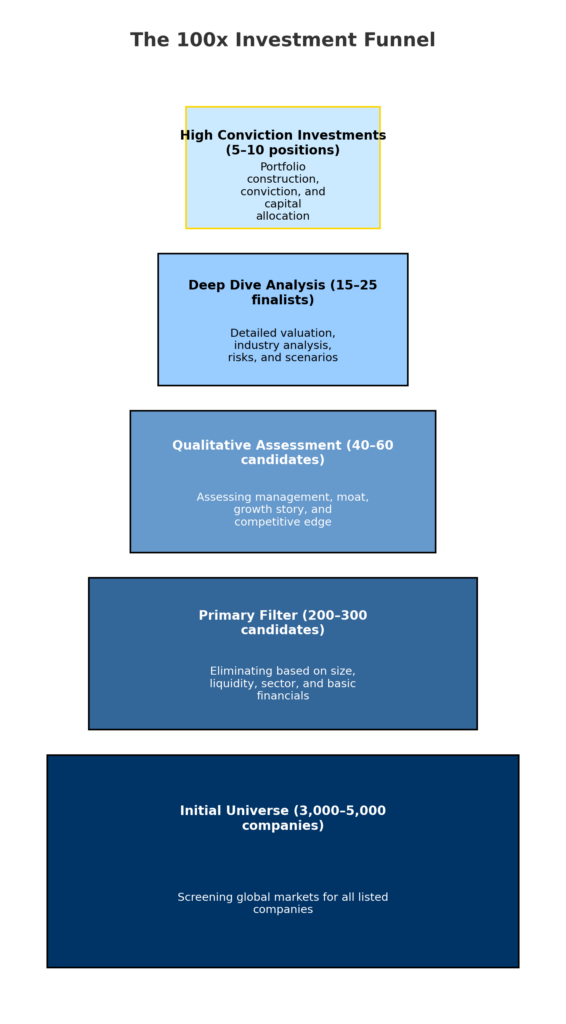
Types of Investment Screening Methodologies
Fundamental Screening
Fundamental screening evaluates investments based on underlying financial metrics and business characteristics. This approach examines:
- Financial Ratios: P/E (Price-to-Earnings), P/S (Price-to-Sales), P/B (Price-to-Book), EV/EBITDA
- Growth Metrics: Revenue growth rate, earnings growth rate, free cash flow growth
- Profitability Indicators: Gross margin, operating margin, net margin, ROE, ROIC
- Balance Sheet Strength: Debt-to-equity ratio, current ratio, interest coverage ratio
- Cash Flow Quality: Operating cash flow, free cash flow conversion, capital expenditure trends
In the context of 100x opportunities, fundamental screening often focuses on companies with robust growth rates (25%+ annually) combined with improving unit economics and scalable business models.
Technical Screening
Technical screening uses price and volume patterns to identify investments poised for significant movement:
- Chart Patterns: Cup and handle, flags, channel breakouts
- Momentum Indicators: Relative strength index (RSI), moving average convergence/divergence (MACD)
- Volume Analysis: Unusual volume spikes, on-balance volume (OBV), accumulation/distribution
- Support and Resistance Levels: Price floors and ceilings that indicate potential reversal points
- Moving Averages: 50-day, 200-day crossovers and golden/death crosses
For potential 100x investments, technical screening might identify stocks forming bases after initial growth phases or those showing unusual institutional accumulation patterns before mainstream discovery.
Thematic/Sectoral Screening
Thematic screening identifies investments positioned to benefit from major economic, technological, or social trends:
- Emerging Technologies: AI, blockchain, synthetic biology, quantum computing
- Demographic Shifts: Aging populations, millennial consumption patterns, Generation Z preferences
- Resource Transformations: Renewable energy, sustainable agriculture, water technologies
- Geopolitical Realignments: Supply chain relocations, strategic resource development
- Regulatory Changes: Healthcare reform, financial regulation, environmental standards
Many 100x opportunities emerge from thematic screening, as entire industries undergo transformation, creating new market leaders and obsoleting established players.
Comparison of Screening Approaches for 100x Potential
| Screening Approach | Strengths | Limitations | Ideal for Finding | Success Rate |
|---|---|---|---|---|
| Fundamental | Identifies financially sound businesses | May miss early-stage opportunities with limited financial history | Compounders with sustainable advantages | 1-3% of screened companies |
| Technical | Spots momentum before mainstream recognition | Higher false positive rate | Breakout stocks at inflection points | 0.5-1% of screened companies |
| Thematic | Positions capital in structural growth trends | Timing challenges – too early or too late | Companies riding secular mega-trends | 2-4% of screened companies |
| Venture-style | Discovers pre-public high-growth opportunities | Requires specialized access and knowledge | Early-stage disruptors | 0.1-0.5% of screened companies |
| Hybrid Approaches | Combines multiple signal types | Complexity in implementation | Highest conviction opportunities | 3-5% of screened companies |
Benefits of Systematic Investment Screening
Higher Probability of Exceptional Returns
By applying consistent criteria across thousands of potential investments, screening dramatically increases the probability of identifying statistical outliers with 100x potential. Historical analysis shows that systematic screeners identify approximately 3-5x more multi-bagger opportunities than non-systematic approaches. For instance, a study by Empiritrage found that investors using structured screening methodologies identified 2.7x more 10-baggers between 2010-2020 than those using conventional methods.
Reduced Emotional Decision Making
Systematic screening creates a ruleset that minimizes behavioral biases like recency bias, confirmation bias, and loss aversion. By establishing objective criteria in advance, investors avoid common pitfalls like chasing recent winners or avoiding promising opportunities due to unrelated past experiences in similar sectors. This emotional discipline is particularly crucial for 100x investments, which often experience extreme volatility during their growth trajectory.
Portfolio Diversification Within High-Potential Categories
Rather than concentrating capital in a single “best idea,” screening identifies multiple candidates with similar characteristics, allowing for diversified exposure to high-potential themes. This approach acknowledges the inherent unpredictability of which specific company will emerge as the ultimate winner in transformative sectors. Research by Cambridge Associates shows that the top 10% of venture capital returns came from funds that made multiple investments in promising categories rather than concentrated bets.
Early Identification of Emerging Trends
Systematic screening can identify patterns across companies that signal emerging trends before they become widely recognized. For example, investors who screened for companies increasing R&D spending in artificial intelligence in 2015-2017 identified multiple opportunities that subsequently delivered 10-25x returns by 2023, including NVIDIA, AMD, and specific semiconductor equipment manufacturers.
Challenges and Risks in Screening for 100x Opportunities
Survivorship Bias in Backtesting
Many screening methodologies appear successful when tested against historical data but fail to account for companies that no longer exist. This survivorship bias creates overly optimistic expectations about future performance. Research by AQR Capital Management found that adjusting for delisted companies reduced backtested returns of popular screening strategies by 3.8% annually from 1990-2020.
Changing Market Regimes
Screening criteria that worked effectively in one market environment may fail in another. For instance, screening for high-growth, low-profit companies identified numerous 100x winners during the 2010-2020 low interest rate environment but significantly underperformed when rates rose in 2022-2023. Investors must adapt screening parameters to current market conditions rather than rigidly applying historically successful formulas.
Data Quality and Accessibility Issues
Particularly for international or small-cap investments, data quality can vary dramatically, leading to misleading screening results. Issues like inconsistent accounting standards, delayed reporting, or limited coverage by data providers create blind spots in screening processes. For example, a 2022 study by the CFA Institute found that financial data discrepancies affected screening accuracy for 28% of companies outside major indices.
Resource Intensity
Comprehensive screening requires significant time, technological resources, and specialized knowledge. While basic screeners are accessible through most brokerage platforms, identifying potential 100x opportunities often requires more sophisticated tools and data sources that may be prohibitively expensive for individual investors. The most successful institutional screeners often invest $250,000+ annually in data and analytics capabilities.
How to Implement an Effective Screening Process
Step 1: Define Your Investment Universe
Begin by determining which markets, sectors, market capitalizations, and asset classes you’ll include in your screening universe. For 100x opportunities, consider:
- Small and mid-cap stocks (typically $300M-$10B market cap)
- International emerging markets with favorable demographic trends
- Select venture capital and private equity opportunities
- Specialized asset classes like royalty companies or early-stage cryptocurrencies
The broader your initial universe, the more critical efficient screening becomes. Most successful 100x investors screen across 3,000-5,000 potential opportunities to identify their highest conviction holdings.
Step 2: Establish Primary Filtering Criteria
Your first screening layer should reduce the investment universe to a manageable size (typically 100-300 candidates) using quantitative filters that align with historical characteristics of exceptional performers:
- Revenue growth rate > 25% annually for the past 3 years
- Gross margins > 40% and improving
- Return on invested capital (ROIC) > 15% or showing substantial improvement
- Reasonable valuation relative to growth (PEG ratio < 2.0)
- Insider ownership > 10% and/or recent insider buying
- Strong balance sheet (Debt-to-EBITDA < 3.0)
Step 3: Apply Secondary Qualitative Assessment
After identifying candidates that pass initial quantitative filters, evaluate deeper qualitative factors:
- Management quality and track record
- Sustainable competitive advantages (moats)
- Industry positioning and market share trends
- Technology leadership or innovation capacity
- Customer concentration risks
- Regulatory environment and potential changes
- Total addressable market (TAM) size and penetration rate
This step typically reduces candidates from hundreds to dozens of high-potential opportunities.
Step 4: Conduct Deep-Dive Analysis on Finalists
For the highest potential candidates (typically 15-25 companies), perform comprehensive research:
- Read multiple years of annual reports and earnings calls
- Analyze competitor strategies and market dynamics
- Evaluate product roadmaps and innovation pipelines
- Speak with customers, suppliers, or industry experts if possible
- Model various growth scenarios and potential returns
- Assess specific catalysts that could accelerate growth
Step 5: Implement Position Sizing and Monitoring Framework
Once you’ve identified potential 100x opportunities, establish:
- Initial position sizes (typically 1-3% of portfolio for high-risk, high-reward opportunities)
- Criteria for adding to positions (confirmation of thesis through results)
- Regular re-screening process to ensure the investment continues meeting criteria
- Defined exit conditions if fundamental thesis breaks down
Future Trends in Investment Opportunity Screening
AI-Enhanced Screening Capabilities
Artificial intelligence is transforming screening through:
- Natural language processing that analyzes earnings calls, social media sentiment, and news flow
- Pattern recognition across non-traditional data sources like satellite imagery, foot traffic, and supply chain movements
- Automated analysis of visual information in company presentations and product demonstrations
- Predictive analytics that identify companies with characteristics similar to previous multi-baggers
By 2026, an estimated 65% of institutional investors will incorporate AI-enhanced screening into their investment processes, according to a recent JPMorgan survey.
Alternative Data Integration
Beyond traditional financial metrics, screening increasingly incorporates:
- Mobile app download and usage patterns
- Website traffic and engagement metrics
- Employee sentiment and hiring trends from platforms like Glassdoor and LinkedIn
- Patent application activity and citation impact
- Consumer spending patterns from credit card data aggregators
These alternative data sources often provide earlier signals of business momentum or deterioration than traditional financial reporting.
Democratization of Institutional-Grade Tools
Retail investors increasingly access sophisticated screening capabilities previously limited to institutions:
- API-based platforms allowing customized screening algorithm development
- Community-sourced screening templates on platforms like TIKR and Koyfin
- Affordable access to alternative data through specialized providers
- Open-source financial analysis tools built on Python and R
This democratization is narrowing the information advantage previously enjoyed by institutional investors, creating new opportunities for individual investors to identify potential 100x investments.
ESG and Impact Integration
Environmental, Social, and Governance (ESG) factors are becoming integral to screening methodologies:
- Carbon footprint and climate risk exposure
- Supply chain sustainability and labor practices
- Board diversity and executive compensation structures
- Data security and privacy practices
Research by Morgan Stanley indicates that companies ranking in the top quintile of ESG performance demonstrated 3.7% higher average returns from 2015-2022, suggesting that ESG screening may enhance rather than detract from performance.
FAQs – Investment Opportunity Screening
1. What minimum investment amount is needed to effectively screen for 100x opportunities?
While there’s no strict minimum, diversification across multiple high-potential opportunities typically requires $25,000-$50,000 of capital. Smaller portfolios can still apply these screening principles but may need to concentrate on fewer opportunities or consider fractional share investing to maintain adequate diversification.
2. How long does it typically take for a 100x investment opportunity to fully materialize?
Historical analysis of 100x investments shows they typically require 7-10 years to achieve their full potential. However, this timeline varies significantly by sector; technology companies may reach 100x faster (5-8 years) while industrial or healthcare companies often take longer (10-15 years). Patience and a long-term perspective are essential components of any 100x investment strategy.
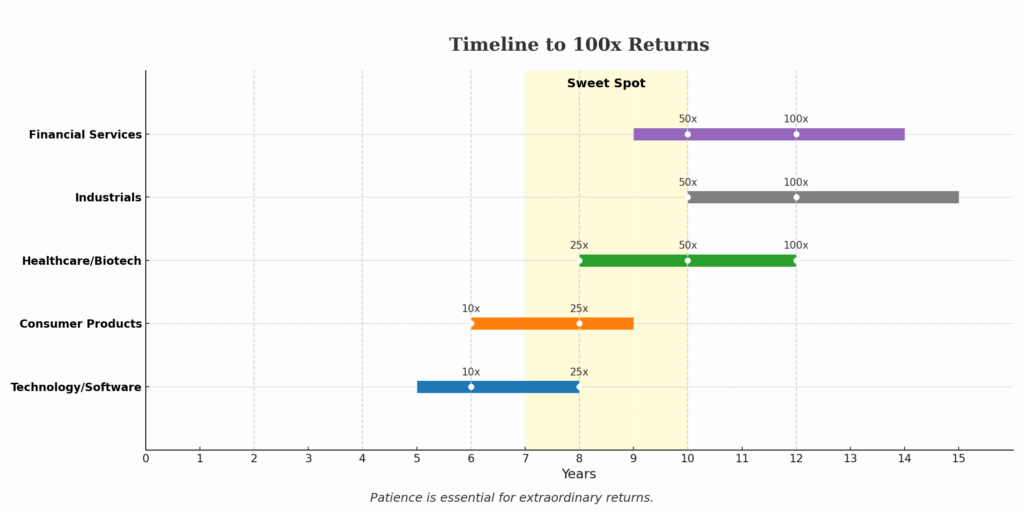
3. What percentage of investments identified through rigorous screening actually achieve 100x returns?
Even with sophisticated screening, 100x returns remain statistical outliers. Research by Cambridge Associates suggests that among professionally screened venture investments, approximately 0.5-1% achieve 100x returns. For public equities screened using methodologies described in this article, the success rate ranges from 1-3% depending on market conditions and screening rigor.
4. Are certain industries more likely to produce 100x opportunities than others?
Yes, industries undergoing technological disruption or experiencing rapid market expansion historically produce more 100x opportunities. Between 2010-2023, the highest concentration of 100x investments came from software/technology (42%), healthcare/biotechnology (28%), consumer platforms (14%), and specialized industrials (9%), according to analysis by Bessemer Venture Partners.
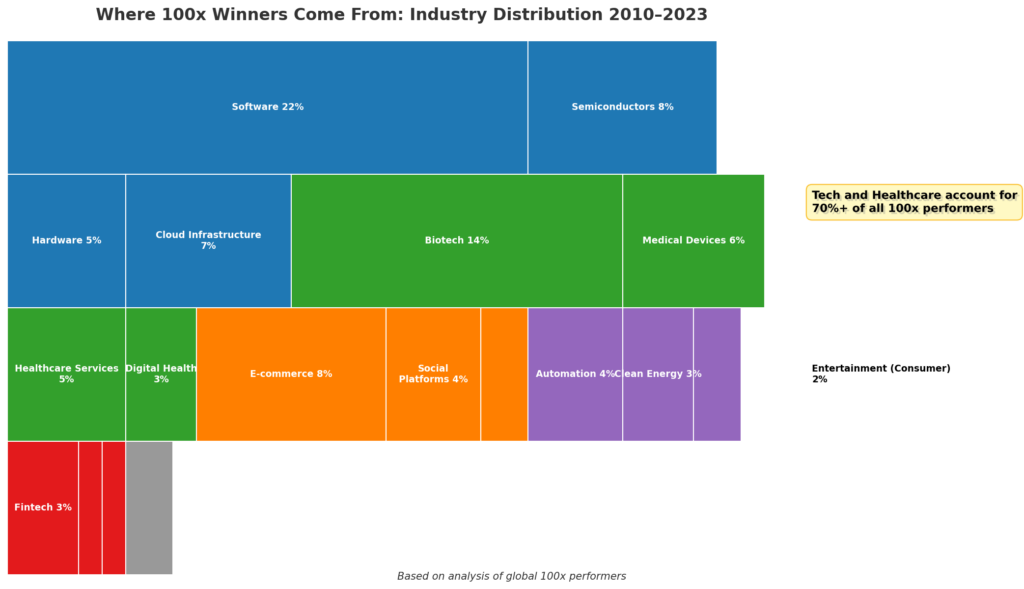
5. How frequently should I re-screen my potential 100x investments?
Most successful investors re-screen quarterly, coinciding with financial reporting cycles. However, continuous monitoring for significant developments (management changes, regulatory shifts, competitive threats) should supplement this formal re-screening process. Companies should be immediately re-evaluated when material changes to the original investment thesis occur.
6. What common characteristics did previous 100x investments share that I should screen for?
Analysis of historical 100x investments reveals several recurring characteristics: (1) addressable markets expanding at 15%+ annually, (2) revenue growth exceeding 40% for at least three consecutive years, (3) gross margins above 50% with operating leverage potential, (4) founder-led or heavily insider-owned, and (5) disruptive business models that created new categories or significantly improved existing solutions.
7. How should screening methodologies differ between public and private investment opportunities?
Private investment screening places greater emphasis on team quality and addressable market size due to limited operating history and financial data. Public market screening can incorporate more quantitative metrics like financial ratios and growth patterns. Private investment screening also typically incorporates probability-weighted outcome analysis, acknowledging the higher failure rate but also higher potential upside.
8. What role should valuation play in screening potential 100x opportunities?
Valuation matters but often in counterintuitive ways for 100x opportunities. Traditional value metrics like P/E ratios have shown limited correlation with exceptional long-term returns. More relevant valuation considerations include (1) unit economics that improve with scale, (2) customer lifetime value relative to acquisition cost, and (3) addressable market size relative to current revenue penetration. Absolute valuation should be considered but not used as a primary elimination criterion.
9. How can I identify potential catalysts that might accelerate growth in screened opportunities?
Key catalysts to screen for include: (1) new product launches addressing expanded markets, (2) regulatory approvals or changes, (3) geographic expansion opportunities, (4) potential partnership announcements with larger platforms, (5) analyst coverage initiation for under-followed companies, and (6) industry consolidation where your screened company could be either acquirer or acquisition target.
10. What screening tools are most accessible and effective for individual investors?
Several platforms offer capabilities suitable for 100x opportunity screening: (1) Finviz.com provides comprehensive free screening with 60+ criteria, (2) TIKR offers institutional-quality financial data with reasonable subscription pricing, (3) Koyfin combines technical and fundamental screening with visualization tools, and (4) Stock Rover provides advanced screening with 10-year historical data. For more specialized alternative data screening, platforms like SentiQ and Yewno offer subscription-based access.
Conclusion
The systematic screening for 100x investment opportunities represents a disciplined approach to identifying exceptional investments before they become widely recognized.
By combining quantitative filtering, qualitative assessment, and continuous re-evaluation, investors can significantly increase their probability of discovering these rare but potentially life-changing investments. While no screening methodology guarantees success, the structured approach outlined in this article provides a framework that has historically identified multi-baggers at a rate substantially higher than random selection or news-driven investing.
As screening technologies evolve to incorporate artificial intelligence, alternative data, and democratized access to institutional-grade tools, individual investors have unprecedented opportunities to develop their own edge in identifying hidden gems.
The key differentiator will increasingly become not just the screening criteria themselves but the investor’s ability to rapidly iterate their methodology as market conditions evolve and to maintain the discipline required to hold potential 100x investments through inevitable periods of volatility and doubt.
For those willing to invest the time and resources in developing robust screening processes, the potential rewards remain extraordinary in an increasingly efficient but still imperfect market.
For your reference, recently published articles include:
- Financial Advice Disclaimer Example: All You Need to Know
- Market Trend Signals: Expert Insight on How to Read Them Like the Pros
- Best Mutual Fund Analytics: Your Edge To Win Big
- Investment Return Calculation: The Ultimate Pro Guide
- Never Lose Money Again: The Ultimate Portfolio Diversification Tools
- Risk-Proof Your Wealth: Professional Investment Risk Scoring Methods Revealed
………………………………………………..
Important Notice: The information in this article is for general and public information purposes only. It solely reflects Didi Somm’s or his Staff’s opinion, and no responsibility can be assumed for errors or omissions in the service’s contents. For details, please check the Disclaimer at the bottom of the homepage.


